Hannah Salisbury, Engagement and Events Manager
Our Document of the Month for May 2018 is an admissions register from the Essex Industrial School for Neglected and Destitute Boys (D/Q 40/1). The volume contains records of boys admitted to the school between 1872 and 1883, giving the reason for their admission and following their school career. For some boys it also records what happened to them after they left the school. Each page reads like a miniature Dickens novel, and the book is full of stories of boys who have been wandering the streets or arrested for petty crimes before being sent to the school.
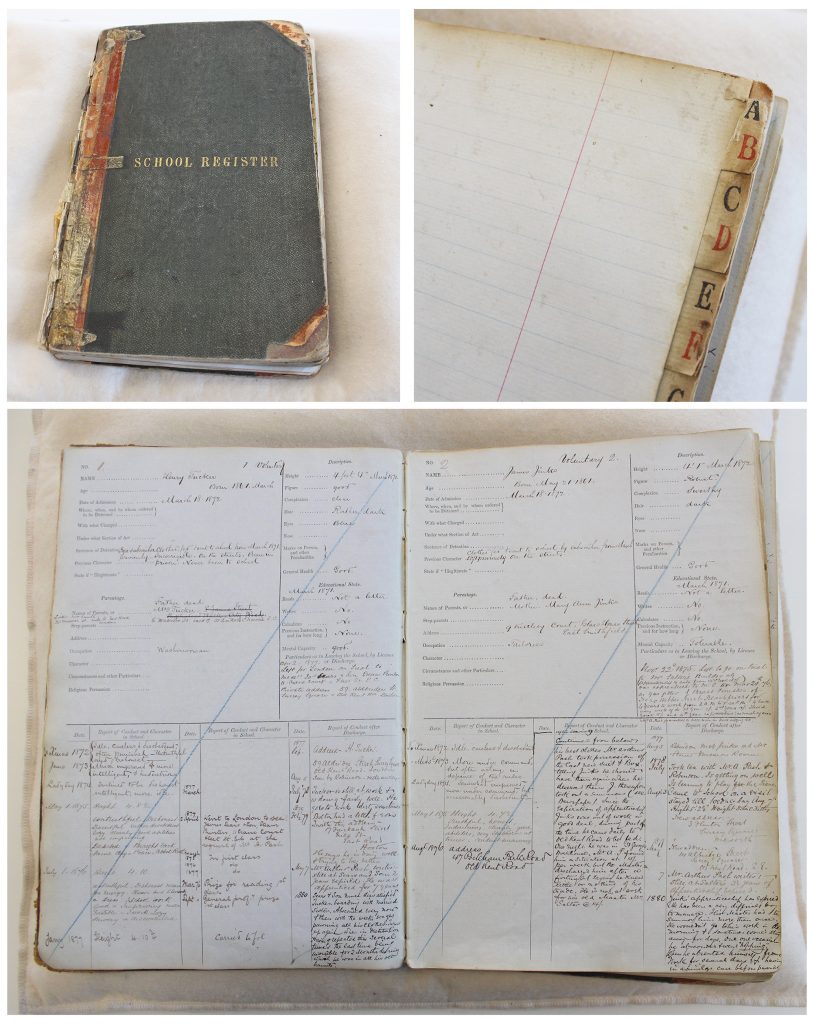
Established in 1872 by local businessman Joseph Brittain Pash, the school started life in two converted houses in Great Baddow, supported entirely by donations. It provided accommodation, clothing, education and practical training for destitute boys, especially orphans or those at risk of falling into crime.
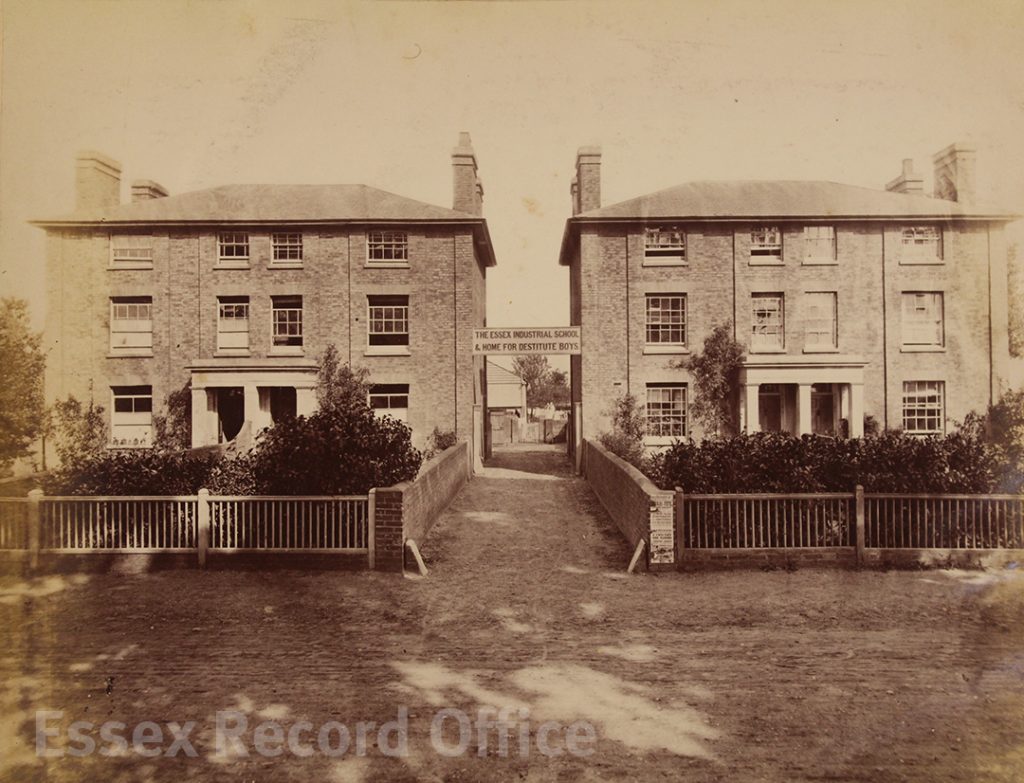
Buildings in Great Baddow used by the school in its early days
The school obviously met a social need, and by 1876 had grown to fill three houses and four cottages. In 1877 it was granted £5,000 by the Essex county authorities and £2,000 by the West Ham School board for a new building. Land was purchased in Rainsford End, Chelmsford, and a new building with space for up to 150 pupils was opened in 1879.
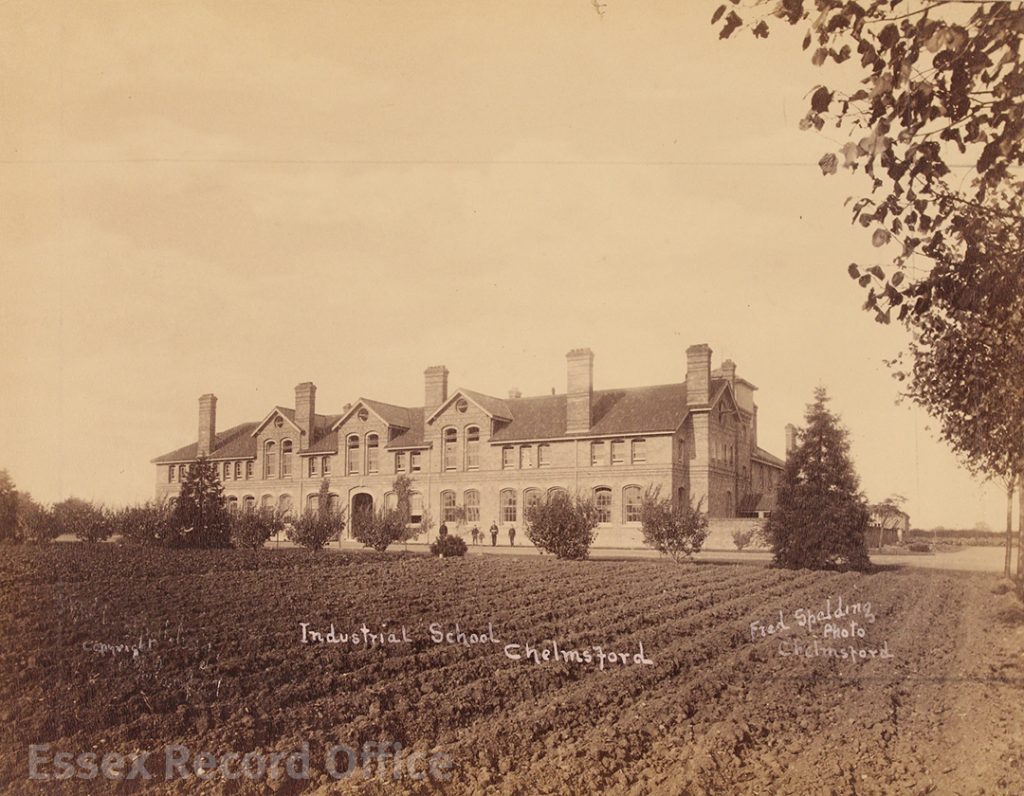
The new school building which opened in Rainsford End, Chelmsford, in 1879
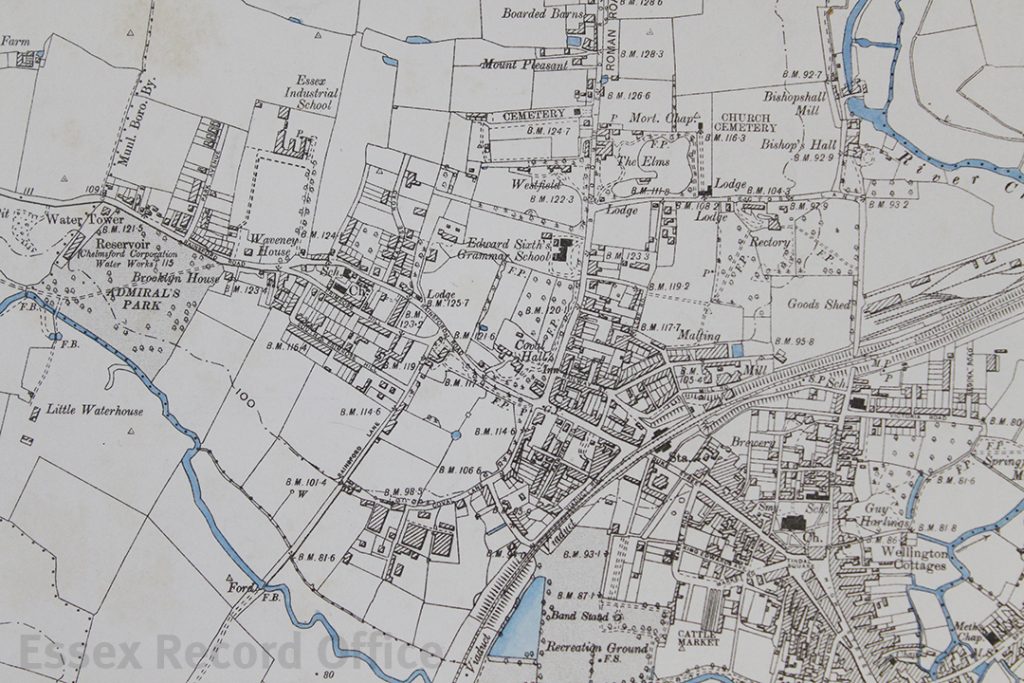
The Essex Industrial School, in the north west quadrant of this map, was built in what was at the time open countryside outside Chelmsford town centre. The building survived until the 1980s when it was demolished and replaced with housing.
Alongside a basic education the boys received training in shoemaking, tailoring, gardening, building, carpentry, painting and decorating, and engineering. The school also had a theatre, a swimming pool, and a fife and drum band. When boys left, attempts were made to find them employment, sometimes in Australia, New Zealand, or Canada.
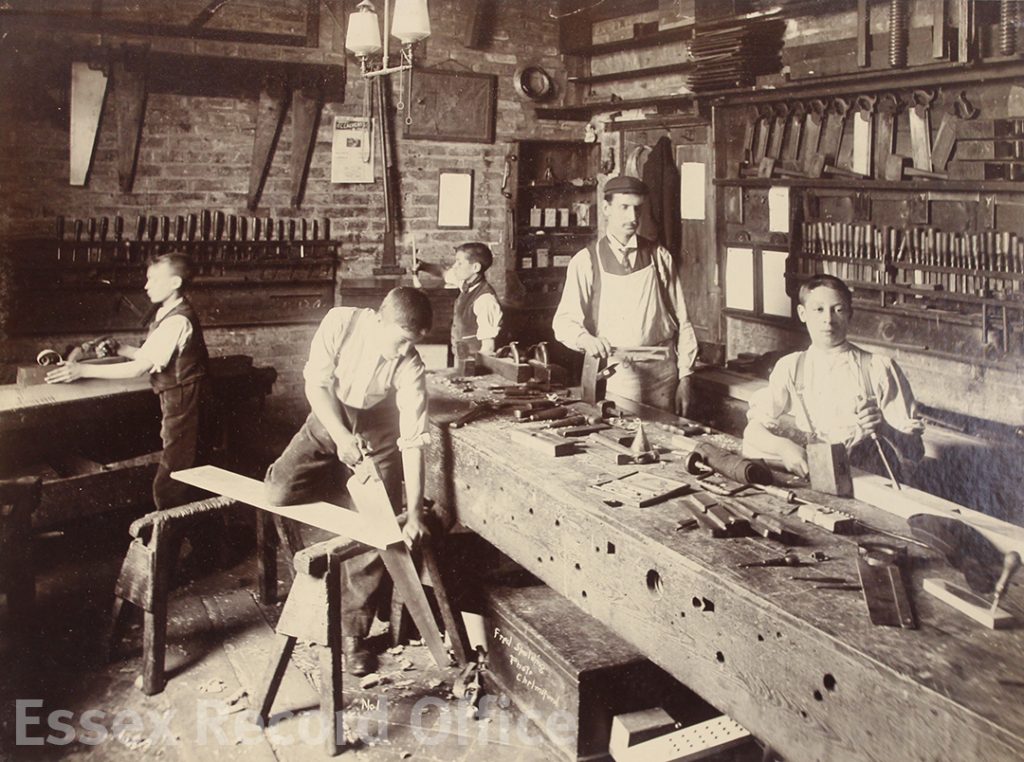
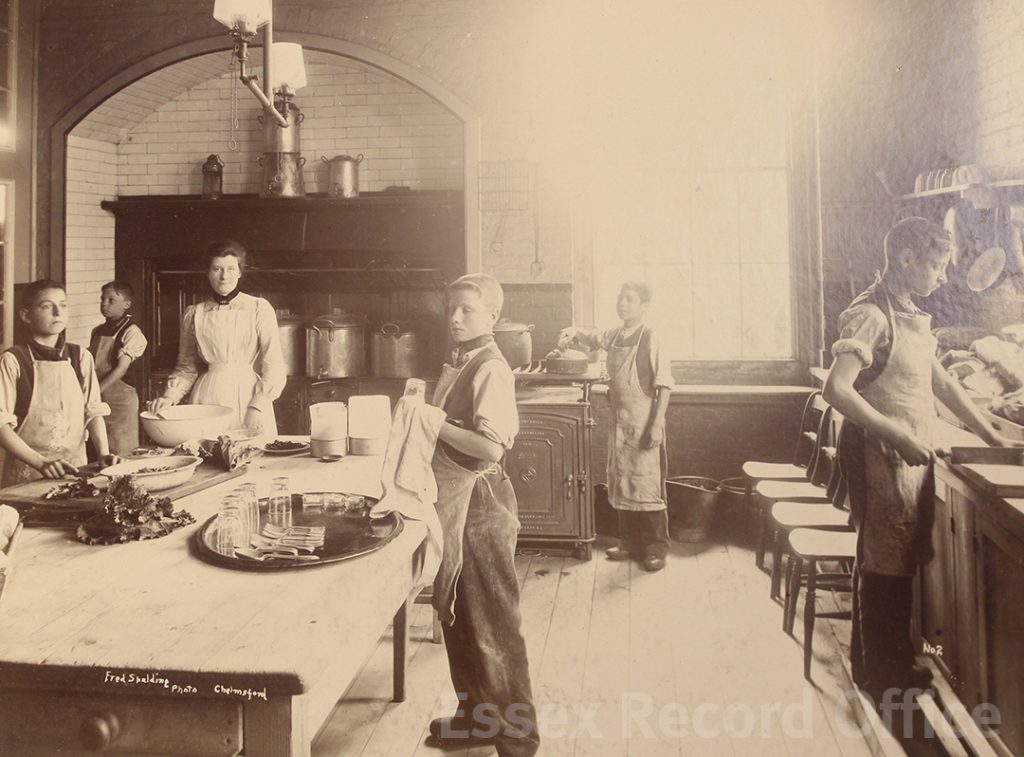
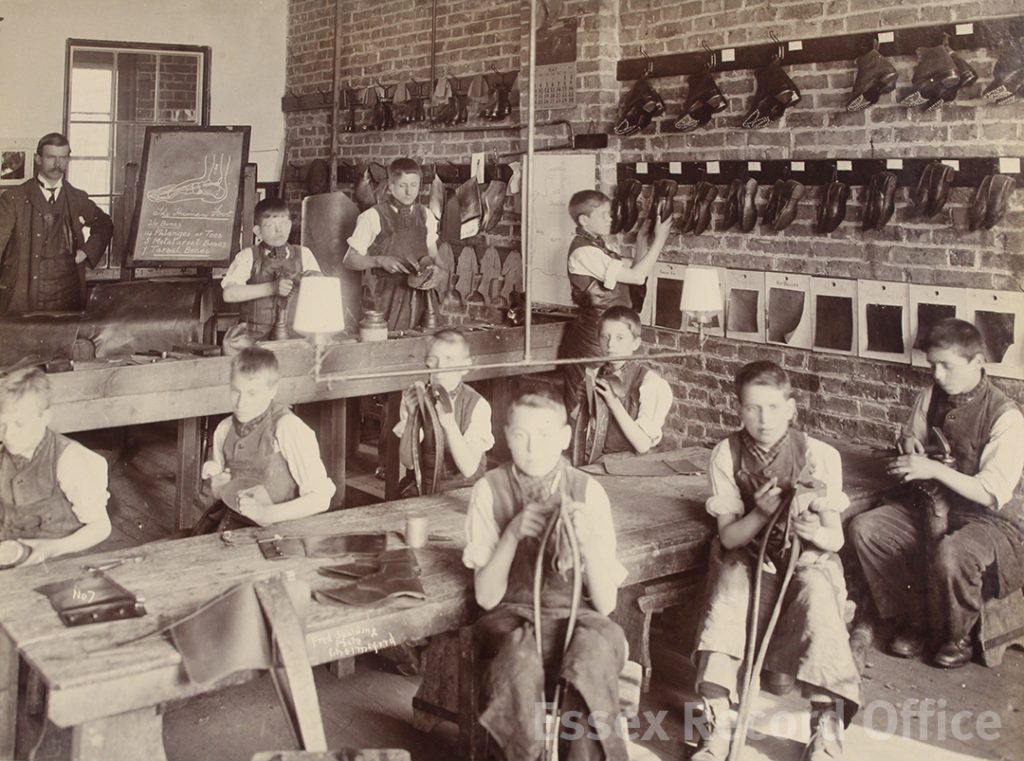
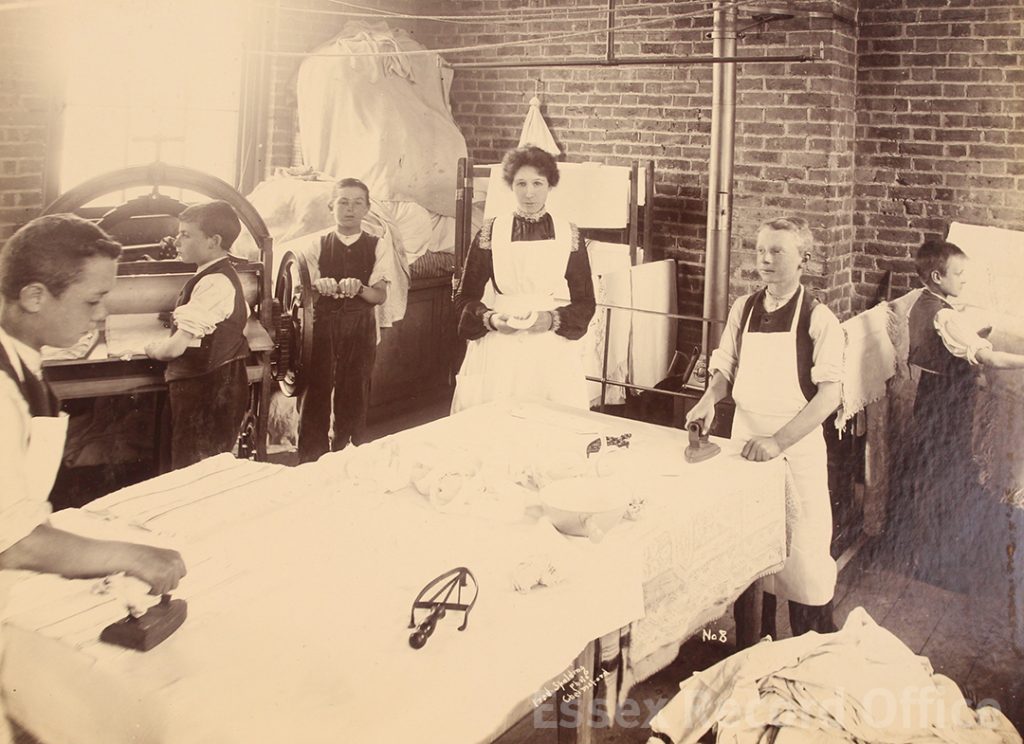
View more photographs from the school on our Historypin page
The school admission register and photographs of the school’s buildings, classrooms and workshops are wonderful enough, but we also have some further photographs which make the whole collection even more special.
The school sometimes commissioned individual portrait photographs of their pupils, and a little bundle of these survived today at ERO, most of which are named. These names can then be looked up in the admissions registers, and the photographs of the boys can be tied up with their stories told in the school records. Some of the photographs were taken after the boys had been at the school for a while, but others were taken when the boys first arrived. Often they were unshod and wearing rags, and had clearly suffered extreme deprivation.
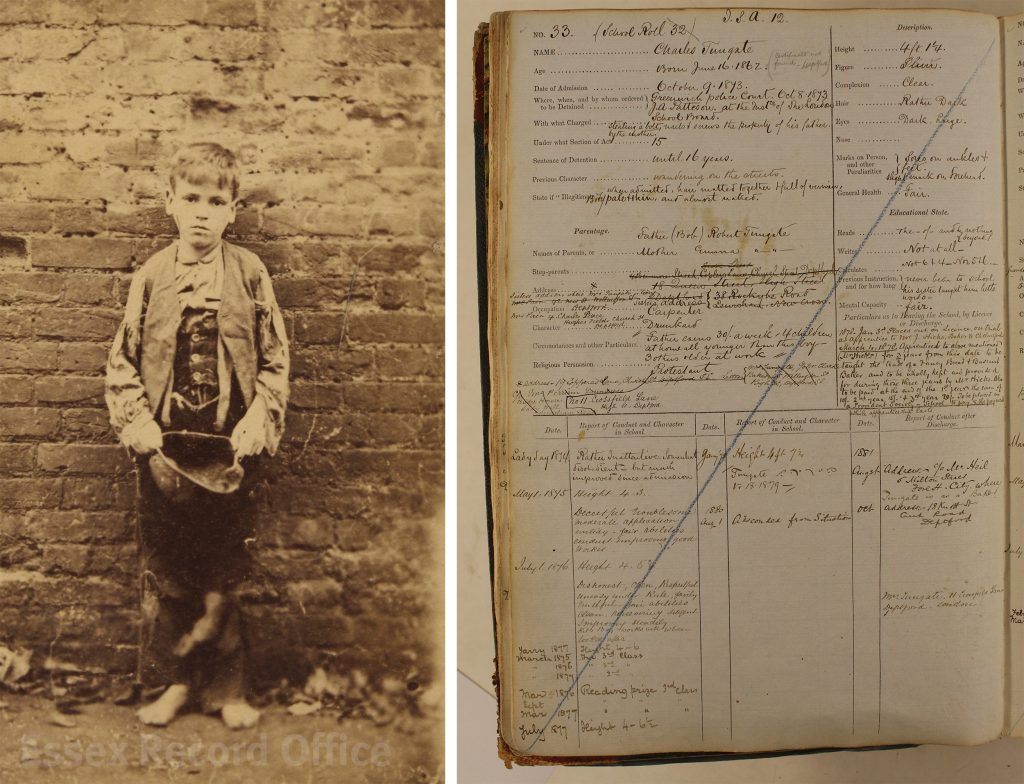
Photograph of 11-year-old Charles Tungate, who was admitted to the school in 1873, along with his page in the admission register.
Charles Tungate was admitted to the school in October 1873, aged 11. His attendance at the school had been ordered by Greenwich Police Court, following his arrest for stealing a bolt, nails and screws which belonged to his father (his mother had reported this crime). He was sentenced to be detained at the school until he was 16 years of age.
The admission register gives a remarkable amount of detail about Charles’s situation. His parents were Robert and Emma Tungate of Deptford. Robert was a carpenter, but is also described as a drunkard. Charles was one of their eight children; three older children were out at work, but four children younger than Charles were at home. Clearly the family was struggling. Charles had been ‘wandering the streets’, and when admitted, his hair was ‘matted together & full of vermin’ and his body was ‘pale & thin, and almost naked’, and he had sores on his ankles and feet. He had never been to school, but his sister had managed to teach him to read a little.
After 11 months at the school, Charles was described as ‘Rather inattentive, somewhat disobedient, but much improved since admission’. Charles’s school reports are something of a mixed bag – he is described as being ‘deceitful’ and ‘untidy’, but also as ‘persevering’ and ‘diligent’. He left the school in 1878 and was apprenticed to a Chelmsford baker, Mr Hicks, ‘to be taught the trade of a Fancy Bread & Biscuit Baker’. Charles lasted two of his three years as an apprentice, before absconding in August 1880. In 1881, however, he had found another position in London as a baker. Baking seems ultimately to have proved not to be for Charles, and in 1884 he joined the army. He served in India and in South Africa, where he suffered a gunshot wound to both legs during the Boer War. By the time of the 1911 census, Charles was living in Warley, and was an army pensioner and grocer. He was married with four children. He died in 1940, aged 75.
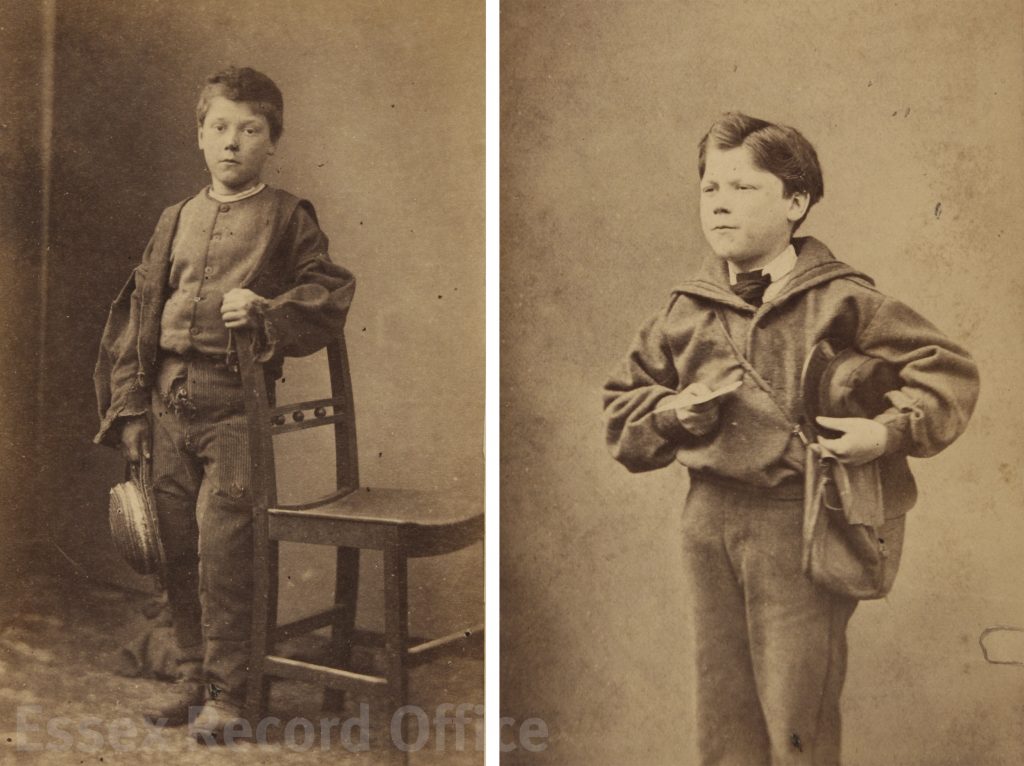
There are two photographs which are labelled ‘G Newman’; the jury is out on whether they are before and after photographs of the same boy or if more than one G Newman attended the school.
George Newman was admitted in 1874 aged 10, having been ‘wandering around with his mother until she became insane’. His father was dead, and his mother was placed in the Essex Lunatic Asylum in May 1874. He stayed at the school until 1880, and wrote in December that year that he had got a job at one of the very first Sainsbury’s shops in London. Sadly when he visited the school in August 1881 he was out of work, and nothing further is reported of him.
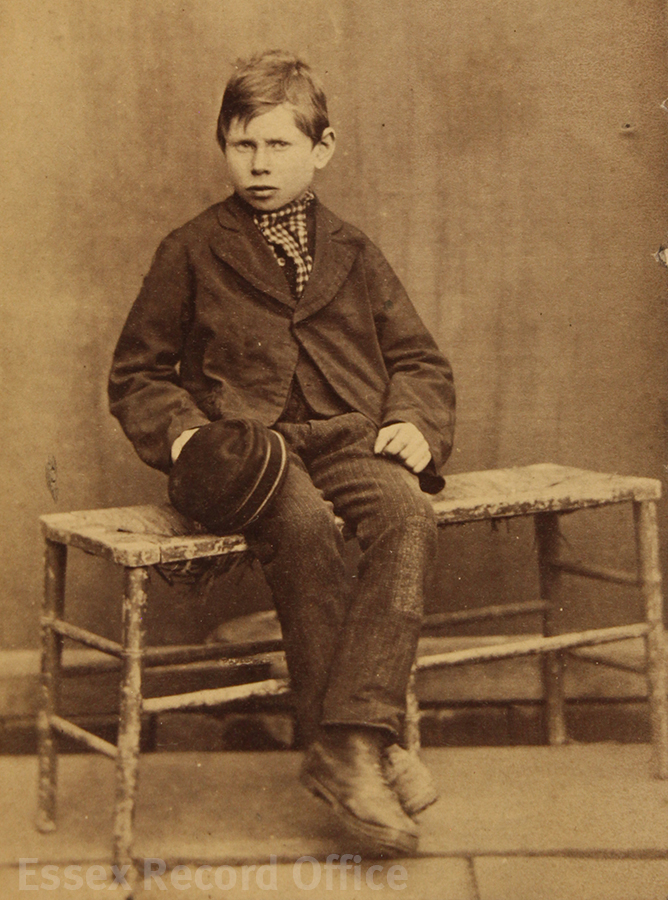
William Swainston, who joined the school in 1876, aged 11, having run been orphaned and run away from his uncle. Photo by Edouard Nickels (D/Q 40/153)
William Swainston was admitted in 1876, aged 11, having been found sleeping rough in an outhouse at Parson’s Heath near Colchester. He was an orphan, and had been living with his uncle, but stated he had run away from his uncle because he was afraid of him. A newspaper article fixed to his school record says that ‘He had been wondering about the locality for a fortnight previously, and witness [a local policeman] had received several complaints respecting him… The witness added that when found the boy was in a filthy condition, and Mr. Charles Harvey, the gaoler, said he had never before in his life had a boy in such a dirty state in custody’. He was described on arrival at the school as ‘a quick boy’ and ‘intelligent’, and unusually he could read and write. In 1881 a position was found for him in Canada, and he wrote to the school to tell them he was doing well. Canadian records show that he married an Irishwoman, and settled in Toronto.
The school was later known as the Essex Home School, and continued in various forms until 1980. The buildings have since been demolished and the site redeveloped.
The admission register, along with photographs of some of the pupils of the school, will be on display in the ERO Searchroom throughout May 2018.

This piece is absolutely fascinating and gives a real insight into the lives of the unfortunates mentioned as well as following through on outcomes . Bravo.
Thank you very much Neil! It’s hard not to try to research every single story in the book. Plenty of projects in there for interested researchers to take up…
These are such moving and interesting stories. Thank you.
Thank you what an interesting post, I will now try and visit ERO to see more. My best friends Dad was the Headmaster of the Home School in the 70’s early 80’s and she will be very interested to read this.
Hi Julie, glad you found it interesting! The register will be on display in the ERO Searchroom throughout May 2018, and if you would like to see it after that date it will be available to order as usual, along with the others in the series which are over 100 years old.
Very interesting thank you. My surname name was Mixture and I wonder how I can research to see if any of my ancestors were in the school? We are from the Chelsford area so it may be a possibility.
Kind regards
Sam
Hi Sam, the admission registers which are older than 100 years are available to order and view in our Searchroom in Chelmsford. There is information about how to visit us here: http://essexrecordoffice.co.uk/visit-us/
However, even though the school was in Chelmsford, the pupils came from across Essex, and in some cases from further afield, so unless your ancestor had ended up on the streets or committed a crime they would have gone to one of the regular local schools in Chelmsford instead.
Hope that’s helpful!
Fascinating
If i wanted to come along, do i need to book a time? What information {other than the name of the boy that was in the school} would i need to bring please? Would i be allowed to photograph the document? Am asking for a friend who lives a long way away, and wondered if i could do a bit of research on her behalf. TIA
Hi Kay, there is some information about visiting our Searchroom here: http://essexrecordoffice.co.uk/research/visit-the-searchroom/
Knowing the name of the boy and having an idea of when he was at the school should allow you to find the right register. It’s worth noting though that only the registers before 1911 are available – school records of this type are subject to a 100 year closure. (We can sometimes undertake a closed record search in documents which are closed to look for specific information.)
You don’t need to book a time, just make sure that we are open. You will need a CARN ticket to order documents – if you don’t have one already you can get one on the day, you’ll just need some ID with proof of your address and signature.
You can indeed take your own photographs of documents. A camera licence is £12 for the day to take as many pictures of non-copyright material as you like. If you just want an image of one page it would be more cost-effective for you to use our reprographics service, where we can take an image for you and e-mail it to you.
Hope that helps! Feel free to drop us a line on ero.enquiry@essex.gov.uk if you would like any further advice ahead of your visit.
I found this to be fascinating. I love reading the stories of those admitted to institutions like industrial schools, asylums and the like.
Do you have the admission books for 1900-1920? I think one of my ancestors was in the Industrial school at this time.
Thanks Deborah, glad you found it interesting!
We do indeed have the admissions registers covering those dates. D/Q 40/3 covers 1897-1911 and D/Q 40/4 covers 1911-1925. However, the latter volume is closed until 2026 (all school records of this type are closed for 100 years). Should the information you are looking for fall in the later volume you could ask us to undertake a closed record search on your behalf.
I hope that is helpful, and do drop us a line on ero.enquiry@essex.gov.uk if you would like any further advice.
What amazing records. My great uncle was here in the 1901 census. His mother had died in 1898 and his father had a drink problem and was prosecuted for child neglect in 1902 only weeks before he died of small pox. I look forward to visiting one day to see these.
It would be fascinating if you could find him! Have you looked in local newspaper records too? Sometimes there are little articles about that sort of case. If you’ve not done so already it’s always worth having a search on the British Newspaper Archive online just in case there’s something there. You can access the site for free at ERO and at Essex Libraries. I’ve found quite a bit on there to add more to the stories of some of the boys at the school.
I have a photograph showing the boys at their annual summer camp at Bradwell-on-Sea. It shows them crammed into 4 farm waggons near the Lilly Ponds on Down Hall Farm. This was close to the beach which is now in front of Bradwell Nuclear Power Station. The farm was owned by Essex County Councilor Alderman Clem Parker who invited the school to regularly camp there.
In the 1950’s I remember visiting the school with our scout group for games sessions and the school was a very familiar landmark when walking into the town.
Hi Kevin, thank you for your comment, do let us know if you would be interested in depositing a copy of the photograph you have with us! If that is something you would like to do you can get in touch with us on ero.enquiry@essex.gov.uk
So the Oranges and Sunshine children story started far earlier than the 20th century…
I was born in Chelmsford, lived in Gt Baddow for 13 years and never ever heard of the Essex Industrial School. We moved to Australia in 1951, but I would love to know where in Gt Baddow the school was situated. I knew of several “big houses” and the brewery but where was the old Industrial School?
Hi Kathy, to be honest I’m not sure exactly where in Great Baddow it was, but there is a picture of it here: https://www.historypin.org/en/essex-industrial-school/geo/51.735587,0.46855,13/bounds/51.691926,0.416479,51.779205,0.520621/paging/1/pin/1106280
I should think historical directories could be a good way to find out. I believe at least one of the houses still exists as the current resident commented on a Facebook post about it.
Its amazing such documentation has been saved in records about such unfortunate children. It was fortunate that these children were given an opportunity to better their living standards and taught a trade so that they had an opportunity to make good of their lives .
I would also like to see a story about the Training Ships in the River Thames such as the Shaftesbury. My grandfather, Frederick Rowland Penn was on the Shaftesbury from 1898 until 1901. From there he joined the merchant ships as a cabon boy.
That would indeed be an interesting story to tell too, but I can’t find much in the way of records on the training ships in our collections. If they belonged to the Navy the records would be with them rather than with us, but I should think there will still be mentions of them in local newspapers.
My great uncles were in an industrial school so this was a great insight.
Hi Alexandra, I’m glad you found it interesting! Have you come across this website? http://www.childrenshomes.org.uk/ You might be able to find some information about the industrial school your great uncles were in.
My husbands family coming me from Essex and some spent time in the workhouse family name Ridgwell (or Ridgewell). Would the children have been educated in this school or elsewhere?
Hi Jacqueline, it’s difficult to say without knowing a bit more. I’ve not come across any boys in the registers who were transferred from workhouses, but I have only scratched the surface of them really. If you would like further advice do get in touch with us on ero.enquiry@essex.gov.uk
Will this book be available online? I live in Canada so am not able to attend the Essex Record Office. Thank you
Hi Veronica, apologies that it’s taken a little while to respond to you, I just needed to check with the appropriate colleague what the position is, and he confirms that it is our intention to publish images of the pre-1911 admission registers soon. We’ll flag up on our social media and in our newsletter once they are up 🙂
Thank you for bringing history to life.
Thank you for your comment Alan! Very glad you found it interesting.
Very interesting. Looking forward to more blogs.
We can’t complain today.
My forebear was an orphan in Esher Industrial School after his parents died so like others I was very interested to read this account about the boys and how they were trained. Why his uncle didn’t take him in I don’t know . Well done on sharing such realistic info
Hi Carol, glad you enjoyed it! There is a similar story in my own family where children ended up in an institution rather than being taken in by family members. Perhaps the wider family couldn’t afford it or thought the children would have better life chances at the school? One of the many questions for us to ponder on!
If Carol’s comment is about William Swainston The Essex Standard of 31 March, 1876 reports the boy’s name as William Henry Swainston. He had been living for four years with a half-brother (not uncle) Charles Henry Swainston but run away. He was sent to the Industrial School for 5 years. Charles Swainston was born in Preston, Hertfordshire in 1834 and lived in Colchester for the 1891 census. There is no obvious birth registration for William.
His subsequent history in Toronto includes a son, William Henry Swainston, who was killed in action with the Canadian Expeditionary Force in France.
Interesting you should say that! I’ve been following up on William’s story, and have another blog post coming out shortly which will look in more detail of what happened to him. Thank you for the information about William’s son, I hadn’t found that bit.
Very interesting to read about the Essex Industrial School. I learned from research that my grandfather, Thomas Morrison, and his brother lived in the Shadwell Industrial School, Yorkshire for 5 years, sad times but having a home and taught a trade was much better than living in the streets. There are photos of their school, unfortunately none of the children, so the excellent photos of Essex School children are precious. Thank you